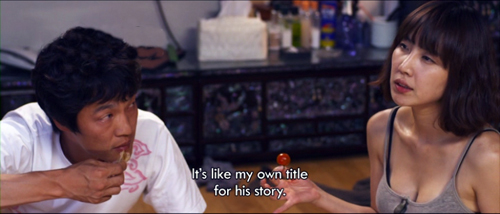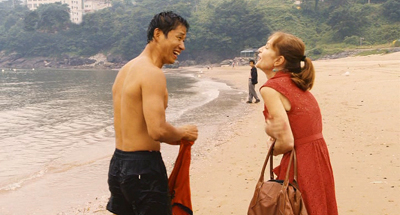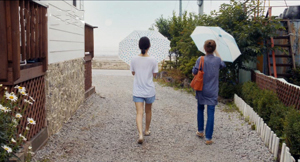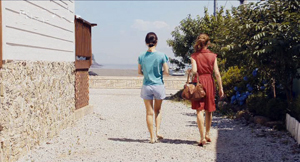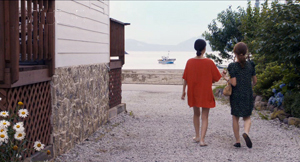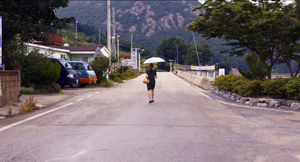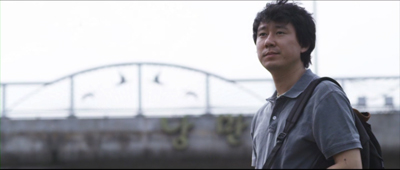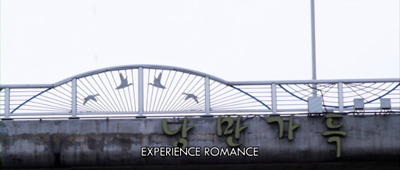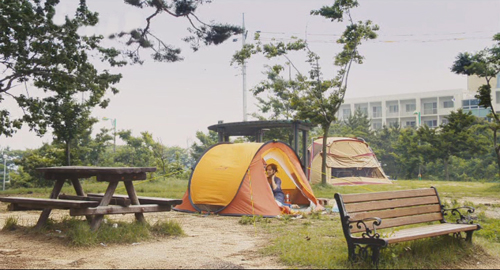Memories are unmade by this
Thursday | October 4, 2012 open printable version
open printable version
Romance Joe (2011).
DB here:
The Vancouver International Film Festival always provides a host of intriguing experiments with narrative form. This year the Dragons and Tigers series, devoted as usual to new films from Asia, offers such a neat pairing of a veteran director and a newcomer that I can’t resist spending some time on them. Both, it turns out, are interested in memory–not just as a theme, but rather as a process involved in how we watch movies.
Passion for pattern
When we analyze a film, we usually notice patterns—an arc of character development, repeated imagery or musical motifs, recurring framings or lines of dialogue. Filmmakers use these elements of patterning to give elements special significance.
Sometimes the patterns we pick out are noticeable on our first viewing of a movie. Indeed, the film’s effect relies on our seeing later elements as completing a pattern.
Remember “You complete me” from Jerry Maguire? The reason you do, I think, is partly because its first appearance is very salient. It occurs when Jerry and Dorothy are riding in an elevator with a mute couple. Dorothy’s explanation of the couple’s signing highlights it (while characterizing her as a sympathetic person who learned ASL to communicate with a relative). When Jerry restates it in Dorothy’s living room, we recall that it’s a simple declaration of love—a straightforward statement from a man who is habitually slick and evasive. The fact that the phrase stuck in Jerry’s mind from the elevator encounter also offers further proof that he’s not as superficial as he seems. He remembered it, and now we do too.
Sometimes, though, we may find patterns that a viewer may not have noticed on first pass. That’s one of the appeals of doing analysis. As we get to know the film more intimately, we see patterns of coherence that probably many viewers didn’t notice before. In classically made films, for instance, a scene is likely to start with a long shot, proceed to two-shots or over-the-shoulder framings, and then toward tighter close-ups. This stylistic patterning follows the rising drama of the scene’s action. Most viewers probably don’t notice these patterns, but directors, cinematographers, editors, and film students are more likely to catch them. When we analyze a film’s style, we may be surprised to find how often these “hidden” patterns emerge.
Very occasionally a filmmaker gives us something in between obvious patterns and buried ones. A film might repeat something in such a way that (a) you recognize it as a repetition on first pass but (b) you can’t recall exactly what it harks back to. In other words, the filmmaker deliberately organized the movie so that the things that come back are difficult to place in the film as a whole.
The best-known example is perhaps Last Year at Marienbad, where the drifting, dreamlike succession of scenes doesn’t supply standard plot progression. The result is that the images, music, and lines of dialogue are felt as echoes of earlier scenes, but most viewers can’t pinpoint exactly where they first appeared. Another instance would be Buñuel’s Discreet Charm of the Bourgeoisie. Here we get scenes that start more or less realistically, and then devolve into absurdity—at which point one of the people in the scene bolts awake in bed. What we’ve just seen is a dream, but we can’t be sure exactly when the dream started because Buñuel and screenwriter Jean-Claude Carrière didn’t supply a scene that shows the character going to bed. One effect is that the movie seems like a daisy-chain of overlapping dreams, with no sure point at which we can declare that this or that moment is real.
Both Marienbad and Discreet Charm rely on a fact of cinema: It unrolls in time. So do novels, of course, in the act of reading anyhow. But when you’re reading a book you can stop and page back to check where you went off-track. Since the arrival of videotape viewing, we can in principle do the same thing, and we’d want to replay moments if we’re undertaking an analysis. But the normal conditions of viewing, in both theatres and at consumer command, bias us toward forward momentum. Intent on what happens next, we have a surprisingly hazy recall of what preceded the scene we’re watching now. Halfway through a movie, try to come up with an accurate scene-by-scene list of what you’ve just watched.
The diffuse memory we have of the prior action, and the difficulty of going back to check, is one reason that films need some explicit patterning, their marked repetitions, their constant restatement of the story’s premises. Redundancy of information compensates for the time-bound nature of viewing. Films that don’t supply this, as in my recent example of Sueño y silencio, demand a second viewing—and risk frustrating audiences.
In another country, at other times
Hong Sang-soo has long been a master of the half-hidden pattern. Each film, usually devoted to the comic deflation of male pretension, is built on a unique armature of repetitions. Most critical commentary simply ignores those, trying to summarize the plots straightforwardly and taking the result as comments on contemporary life—an urban milieu in which intellectuals eat, drink too much, smoke endless cigarettes, and make clumsy attempts at romance and sex. “People tell me that I make films about reality,” Hong remarks. “They’re wrong. I make films based on structures that I have thought up.” It’s the structures, I think, that engage us, and partly by asking us to test our memories of what we saw only an hour or less before.
For instance, The Virgin Stripped Bare by Her Bachelors (2000) at first seems a straightforward he-said/ she-said plot. Initally, scenes showing us a love affair’s progress are organized around one character. Then the affair is replayed, but centering on another character. Many scenes show us each character apart, but when they’re together, that scene gets repeated in the second character’s story. The problem is that some significant details are different in the two versions. We’re asked to wonder whether we’re getting the same story as each character remembers it, or two alternative universes in which the stories differ slightly. Moreover, it’s not easy to recall whether this or that prop or line of dialogue was precisely the same in the first presentation. The strain on our memory is part of the film’s fascination.
Hong has been a regular in the Dragons and Tigers sidebar over the years. He’s reliably prolific: two of his best films, both made in 2010, were in that year’s program. This year brought us another Hong brain-teaser and funnybone-tickler, In Another Country. It’s a measure of Hong’s growing international reputation that Isabelle Huppert is recruited to play three roles in another mazelike plot.
Yonju, staying with her mother in a coastal hotel and beset by family problems, tries writing film scripts. In the first, Anne, a French filmmaker, is vacationing with a South Korean director and his pregnant wife. As Anne gets involved with a hunky, good-natured lifeguard, the director is also making a play for her. Cut back to Yonju, trying another draft. In this one, Anne is a rich housewife from Seoul having an affair with a married man—again a director, but played by a different actor. As she waits for him to join her at the hotel, she meets the same lifeguard and romantic complications ensue. Back to Yonju trying another draft. Now Anne is accompanied by another woman, an older professor. They meet the first director, pregnant wife again in tow, while Anne has become preoccupied with getting life advice from a monk. Once more, needless to say, the lifeguard plays a central role.
As you’d expect with a multiple-draft narrative, the changes are accompanied by some constants—an evening barbeque, the lifeguard emerging from the sea, an encounter between him and Anne in his tent. There are even repeated ellipses, bits that are skipped over in each mini-story. For instance, in all three drafts Yonju, acting as hostess, starts to take Anne on a shopping trip and promises to show her something interesting. But then we cut to Anne alone, wandering through town. Why did the women separate? Is this Anne on a different occasion?
Most to the point of memory tricks, we’ll see something in a late scene that may result from something we saw in an earlier draft. When a bottle of liquor breaks on the beach late in the film, you might remember that a previous scene showed the bottle there already broken—but which scene, in what point, in what story? It’s as if Yonju’s different versions have contaminated one another, with scenes from one draft taken for granted in a different version. In the third draft, what Yonju promised was so interesting seems to be the lighthouse. We may forget that in the earlier versions, we never knew why Anne was searching for the lighthouse. Still, we’re unlikely to forget the parallel framings.
This sort of play with our memory can bring the movie to a satisfying, if enigmatic, conclusion. An umbrella, a casual and forgettable prop in one version, provides a kind of minuscule climax in the last. And the final shot of Anne walking into the distance becomes a variant of the film’s first one.
In Another Country provides plenty of social comedy. Hong’s customary satire of Korean males’ awkward sexual aggressiveness is now accompanied by digs at westerners’ search for mystic Asian enlightenment. But the narrative structure is amusing in itself. Hong cajoles us into enjoying the surprising but inevitable recycling of situations, lines, and camera setups. Few filmmakers can make audiences laugh at the mere appearance of a shot and tease us to expect a replay of or departure from what we’ve already seen. Even if we couldn’t say precisely when we saw that image before, we recognize it and participate in a light-hearted game—the game of form.
Wristcutters share their stories
Romance Joe (2011) was made by Lee Kwangkuk, Hong Sangsoo’s assistant director on many projects. No surprise, then, that his debut relies on parallels and variants. Yet it’s much more explicitly about storytelling than In Another Country. Hong uses Yonju’s script drafts as a peg to hang his variations on, but he doesn’t suggest he’s exploring the very nature of narrating. Lee puts fiction-making at the center of his game.
It would be misleading to summarize the plot, since the film aims to put any firm sense of what really happened into question. The core, we might be tempted to say, is the story of a schoolgirl, Cho-hee, who is shunned because she has had sex with an unnamed man. A boy in her class takes pity on her, and when he finds that she has slashed her wrists in a forest glade, he rescues her. They tentatively fall in love and flee to Seoul. On their first night there, he takes fright and returns home. Left alone, she turns to prostitution, and years later, when the boy is now in Seoul in film school, she agrees to participate in a student film he’s crewing. He doesn’t recognize her. More years pass, and the boy is now a film director. He returns to the village, recalls their runaway romance, and in despair attempts suicide. Meanwhile, Cho-hee’s son, whom she has left with her grandparents, comes to the village in search of his mother.
I think it’s fair to say that even this bare-bones anatomy of Romance Joe isn’t fully registered on a first viewing. And in any case, my synopsis is misleading. Why? Because many of these actions are presented as intersecting tales told by two characters who don’t know one another. A Seoul screenwriter recounts the story of the boy’s search for his mother as a purely fictitious one, an idea he has for a script. Alongside that tale, but not precisely inside it, we see Lee, another writer who’s blocked on a story and visits a village to compose a film. There he spends a long night with a tea lady-hooker, Rei-ji, who takes over storytelling duties. Like Scheherazade, she regales him with another story (see our top still). Her tale focuses on the suicidal screenwriter she calls “Romance Joe”–who turns out to be a filmmaker who has gone missing.
So we have one character telling the story of another character who’s hearing a story presented by Rei-ji–a story about yet a third filmmaker, the despairing director, and one that includes his own memories. More confusingly, Rei-ji’s story not only overlaps with the boy’s quest; she becomes a character in the first screenwriter’s imaginary plot. To add to the intricacy, the film employs only partial framing situations, so we might get a scene establishing one tale’s telling, then the embedded tale, and then another situation of telling, as if what we’ve just seen was launched by one storyteller but picked up by another. Instead of a Chinese-box or Russian-doll structure, with one tale neatly enclosed in another, we get something like a cut-and-shuffle mix. And like In Another Country, this film doesn’t wrap things up by a return to the narrating frame; we’re left with something more ambivalent–a question about the very status of the whole assemblage of stories.
It sounds choppy, but it all flows. As one scene slips into another, with abrupt reminders that we’re seeing events told by someone or other, we’re confronted with a cascade like that in Discreet Charm of the Bourgeoisie. We’d be unlikely to recall the precise moment when one story melted into another. Storytelling is linked to rumor and gossip, chiefly by the fact that the trigger for Lee’s initial writer’s block is the suicide of a major actress, supposedly hounded by innuendo. The chief parallel is to Cho-hee, driven to suicide by malicious classmates, but other characters sport the scars of slashed wrists. In this context, the motifs of rumor and suicide tie together the stories conjured up by each of the narrators–again, apparently operating in some predetermined harmony.
Throughout, our uncertainty is increased by some tantalizing misdirections. Might Rei-ji, not Cho-yee, actually be the boy’s mother? Has Lee, after hearing Rei-ji’s story, created the very film we have watched? Finally, the possibility that Rei-ji is no less a fictioneer than the professional writers is broached when she returns to the teahouse and tells the younger hooker that you can make more money through talk than through sex. “Everyone wants a different story. Put some thought into what clients want.” In telling one screenwriter a story about another one, she’s just suiting the service to the customer.
When we study narrative we naturally emphasize the main plot points, the twists and climaxes that claim our attention, the hints that pay off: the gun in the first act that goes off in the last. But films like In Another Country and Romance Joe remind us, as Roland Barthes put it, that “reading is forgetting.” By planting items that will become important later, filmmakers keep us focused on what’s to come and eventually mobilize memory to make all the pieces fit. But filmmakers can also seed their plots with small things that we barely register, then bring them back as half-recalled items. Films like Hong’s and Lee’s are more than puzzle movies; they induce our imaginations to grapple with the limited capacity of our memories. Those limitations in turn affect how we judge characters and the truths of the tales they bear. And in films like theirs, as often in life, our judgments have to remain in tense suspension.
I discuss problems of viewers’ memory in “Cognition and Comprehension: Viewing and Forgetting in Mildred Pierce,” in Poetics of Cinema. I consider Jerry Maguire‘s narrative organization in The Way Hollywood Tells It. For previous VIFF entries that examine complex narration and plot structure, go here and here.
P.S. 5 Oct 2012: Sean Axmaker, with whom we spent many lively hours at VIFF, has posted reviews of several Asian films, including Romance Joe, at Parallax View.
In Another Country (2012).












